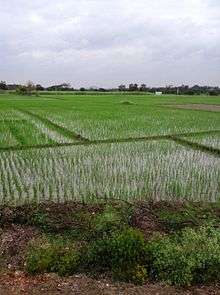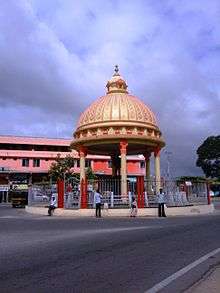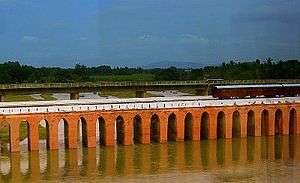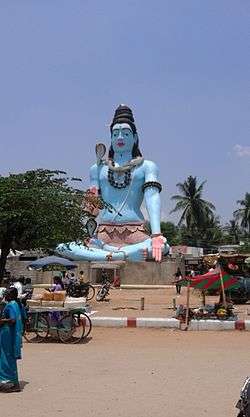Nanjangud
| Nanjangud ನಂಜನಗೂಡು Nanjanagoodu | |
|---|---|
| town | |
|
Srikanteshwara Temple at Nanjangud | |
| Coordinates: 12°07′N 76°41′E / 12.12°N 76.68°ECoordinates: 12°07′N 76°41′E / 12.12°N 76.68°E | |
| Country |
|
| State | Karnataka |
| District | Mysooru |
| Elevation | 656 m (2,152 ft) |
| Population (2011)[1] | |
| • Total | 50,598 |
| Time zone | IST (UTC+5:30) |
| PIN | 571 301 |
| Telephone code | 08221 |
| Vehicle registration | KA-09 |
| Website | www.nanjanagudutown.gov.in |

Nanjangud ( Kannada: ನಂಜನಗೂಡು ) is a town in Mysore district in the Indian state of Karnataka. Nanjangud lies on the banks of the river Kapila (Kabini), 23 km from the city of Mysore. Nanjangud is famous for Srikanteshwara Temple. Nanjangud is also called "Dakshina Kashi" (southern Kashi).[2] This city is also famous for a variety of banana grown in the region, the Nanjanagoodu rasabale.[3]
Origin of the name
The Srikanteshwara Temple at Nanjangud is dedicated to the Hindu supreme deity Shiva, also called Sri Nanjundeshwara, ("The Lord who drank poison") to save the earth.[2] In Hindu mythology, the Gods and demons churned the ocean in search of the ambrosia. During this churning, poison emanated first, followed by ambrosia. To prevent the poison from spreading across the universe, Shiva drank it. His consort Parvati then held his throat tightly to prevent the poison from spreading to the rest of his body. The poison remained in his throat, making it blue in colour. For this reason, Shiva is also called Neelakantha, or "the blue-throated one". Nanjanagud literally means "the place where Nanja (Nanjundeshwara) resides" in Kannada - Nanja is a short form of Nanjunda (Najannu unDava - one who drank poison), or "home of Nanja (Nanjundeshwara)". Srikanteshwara translates to Sri meaning auspicious, Kanta meaning throat and Eshwara meaning Shiva.
History
Nanjangud has been a major Shaiva centre for nearly a thousand years. Chola Kings in the 11th – 12th century are considered to have set in motion the construction of the temple with significant additions by the Hoysalas and the Vijayanagara kings.[4] This temple was later renovated by the Hoysala kings. Both Hyder Ali and Tipu Sultan had close associations with this temple. The Wodeyar kings of Mysore made various grants to renovate the temple.
Geography
Nanjangud is located at 15°07′N 76°41′E / 15.12°N 76.68°E.[5] It has an average elevation of 657 metres (2155 ft). The taluk borders Mysore taluk of Mysore district to the north, T Narsipur taluk of Mysore district to the east, H D Kote taluk of Mysore district to the west and Gundlupet and Chamarajanagar taluks of Chamarajanagar district to the south.
Nanjangud Town is the headquarters of Nanjangud Taluk which contains 5 hoblis and around 180 villages.[3]
WikiMapia.org Link:[6]
Getting there
Buses are available from Mysore and Chamarajanagar. The nearest airport is Bangalore.

Nanjangud has a railway station where only slow trains stop. Trains are available from Mysore at 4.50 am, 7.10 am, 8.50 am, 12.20pm, 2.40pm and 1.40pm. Returns trains to Mysore are available at 7.38 am, 10.00 am, 11.28 am, 3.38 pm, 5.38 pm, 6.43 pm and 9.33 pm.
Places to see
Shri Raghavendra Swamy matha : Less than 500 mts from the Shri Shrikantheswara temple, there is a matha of Shri Raghavendra swamy. This matha has the distinction of having the only stone image of shri Raghavendra swamy, besides the vrundavana of Shri Rayaru. Besides, there are moola brundavanas of 5 swamijis in the lineage of Shri Raghavendra swamygalu.
Nanjundeshwara Temple

The town is famous because of the huge temple dedicated to Lord Nanjundeswara also referred to as Srikanteswara. It is believed that sage Gauthama stayed here for some time and installed a Lingam, the idol form of Shiva. Nanjangud is also known as Dakshina Kashi or Varanasi of the South.[3]
The temple was originally built by the Ganga rulers in the 9th century during their occupation of this region. The residing deity of the temple was later called Hakim Nanjunda; as given by the Tippu Sultan as it is said a favorite elephant of his was cured after prayer was offered to the deity. The same story is attributed to Hyder too (as per Mysore Gazetteer)! It is said and inscribed in the temple history that his favourite and beloved elephant was bestowed with eyesight by the Lord, after Tippu Sultan's vow with the local deity. The Sultan then had a Lingam made of jade along with an emerald necklace and donated it to the temple. The Vaidya Nanjundeswara, even today is said to be a healer for his believers, and one can see even today worshippers doing Urulu seve, a ritualistic practice after taking bath in the Kapila river.
Veda Brahma. T. S. Vishweshwara Dikshith is the composer of world-famous Sree Srikanteshwara Suprabhata Stotram of Lord. Srikanteshwara of Nanjangud. Sri. T. S. Vishweshwara Dikshith was a learned Sanskrit scholar in several Vedas (Yajur Veda in particular) and specialised in Ghana Krama - which is the essence of the Vedas. He also composed the Sree Sharada Suprabhata and Sree Chandramoulishwara Suprabhata of Sri Sharada temple, Shringeri and Sri Chandramoulishwara temple in V. V. Mohalla, Mysore respectively. He was a Ghana Pati and had mastered several Shastras such as Alankara Shastra, Jyothishya Shastra (Astrology), Tarka, and Vyakarana (Literature) to name a few. He received several awards and accolodates from the Maharaja of Mysore, their holiness the pointiffs' of Sringeri Sharada Peetham and Kanchi Kamakoti Peetam respectively for contributions made to Sanskrit Literature.
Twice every year thousands of worshippers gather for the famous Chariot Festival locally known as the Dodda Jathre and the Chikka Jathre. Idols of Lord Srikanteshwara, Goddess Parvathi, Lord Ganapathi, Lord Subramanya and Lord Chandikeshwara are kept in five separate chariots and a traditional puja is performed to the idols early in the morning on the Jathre day. After the puja, chariots are flagged off. Thousands of devotees pull the Chariots carved out of wood, across the streets of the old town. The town remains immersed in festivities on the Jathre days.

Parashurama Kshetra
Near Nanjangud is the sangam, where the Kapila and Kaundinya rivers meet. This place is termed as Parashurama Kshetra which is where the sage Parashurama is said to have cleansed himself from the sin of beheading his mother.[3]
It is said that Parashurama got immense peace of mind at this place which he did not get anywhere else. So he decided to make a penance at the place where Nanjundeshwara temple presently exists. At that time, only Adi Keshava Temple existed (which is now by the side of main-shrine). While cleaning up the place with his axe, he accidentally hit the head of Lord Shiva, who was performing penance underground. Blood started flowing and Parushurama was frightened to have committed another sin. Then Lord Shiva consoled him not to worry and build a temple of his, adjacent to Adi Keshava's. Lord Shiva also told Parashurama to perform penance at Nanjangud. Parashurama performed at the place where his temple presently is located. Lord Shiva was then immensely happy with it and gave blessings that those who visit Nanjangud should definitely visit Parashurama temple to complete their pilgrimage effectively and fruitfully. [7]
Oldest bridge in India

The bridge across the Kabini has been declared as the oldest bridge with both railway line and road on the same bridge. It is located at the entrance of the temple town here. The meter gauge railway line is across the Kabini river.
The bridge, built in 1735, is now 281 years old and has been declared a Heritage Monument by the Government of India.[8][9]
Prasanna Nanjundeshwara Temple
An old Shiva Temple, just 50 meters off the Kozhikode-Mysore-Kollegal Highway, Karnataka 571302, India (LatLong - 12.156037, 76.680267), Recently taken under the care of Karnataka Muzrai Department and rejuvenated the last couple of years. A calm and unexplored temple worth visiting.

Guru Dataatreya Swamy Temple
Dattaatreya Temple is located near Chamundeshwari Temple near to the banks of River Kapila. Sri Maha Sharabheshwara and Sri Pratyangira Devi is also installed in this temple.[10]
Other attractions
Scenic places within a 100 km radius of Nanjangud include Bandipur National Park, Shivsamudram, Kabini Reservoir etc.[3] and Chamundheswari temple of Chamundi hill near Mysore, Sutturu, Male Mahadeshwara temple and Devanur Mutt (The Great saint Gurumalleshwara), (Devanoor Village, Nanjangud Taluk)-571301, 15 km from Nanjanagudu.[11] Nanjangud is also surrounded by scenic villages like Thandavapura and Chinnadagudihundi which are filled with cute little temples and lush green vegetation. These villages are within one hour distance and can be used for day trips and picnics.
Ayurveda
Nanjangud is famous for the Ayurveda medicines manufactured by the Late Sri B.V. Pandit. The Sadvaidyashala established by him serves people very successfully. Ayurvedic medicines produced here are marketed all over India. In earlier times (1950–70) a tooth powder brand made locally called 'Nanjangud Hallupudi' was also very famous all over Karnataka. Currently B.V Pandit's grand Daughter Kalpana Pandit is a famous Movie star.
Economy
Nanjangud is a home to many industries which are mainly located in the Nanjangud Industrial Area which is spread across 534 acres (2.16 km2). It all started with the now closed Sujatha Textile Mills (STM) which at its peak used to employ about 3000 people. Since then, STM has closed down. However, there are other industries which thrived. There are 36 major industries, 12 medium industries and 35 small-scale units at Nanjangud. According to NIA, Nanjangud is the second highest tax-paying (sales tax of over Rs400 crore a year) taluk in the State after Bangalore. Bannari Amman Sugar factory in Nanjangud has a cane crushing capacity of 7,500 TCD.
Nanjanagudu Banana
A popular variety of banana locally known as Nanjangud Rasabaale has also made Nanjangud famous all over the region. Nanjanagudu banana has been accorded Geographical Indication (GI).[12] Its GI tag is 29.[13] However Nanjangud rasabale is now confined to only around 30 acres
Kayyar Kinhanna Rai has authored a famous Kannada poem "Nanjanagudina Rasabaaley" titled "Hannu Maruvavana Haadu".[3]
Image gallery
 Chinnadagudihundi Cross
Chinnadagudihundi Cross Alamburu temple
Alamburu temple Raghavendra Mutt
Raghavendra Mutt
Location
 |
Mysore |  | ||
| Heggadadevana kote | |
Kollegal | ||
| ||||
| | ||||
| Ooty |
See also
- Mysore Junction
- Kadakola
- Begur, Gundlupet
- Thandavapura
- Sujatha Puram Halt
- Chinnada Gudi Hundi
- Chamarajanagar
- Mysore–Chamarajanagar branch line
References
- ↑ "Census of India Search details". censusindia.gov.in. Retrieved 2015-05-10.
- 1 2 "Nanjangud Town Municipal Council, Karnataka". Nanjangud Town Municipal Council. Retrieved 2013-07-25.
- 1 2 3 4 5 6 "Nanjangud". Retrieved 2012-08-28.
- ↑ "Official Site of Gov of Karnataka".
- ↑ "Falling Rain Genomics, Inc - Nanjangud". Fallingrain.com. Retrieved 2012-09-16.
- ↑ "Location on wikimapia". wikimapia.org. Retrieved 2016-05-01.
- ↑ "Mysore District Information". Mysore.nic.in. Retrieved 2012-09-16.
- ↑ "WebHost4Life | Web Hosting, Unix Hosting, E-Mail, Web Design". ourkarnataka.com. Retrieved 2016-05-01.
- ↑ "Samyuktha Harshitha: The oldest Railway bridge". samharshbangalore.blogspot.in. Retrieved 2016-05-01.
- ↑ "Guru Dattaatreya Swamy Temple, Nanjangud | Nanjangud.Info". nanjangud.info. Retrieved 2016-05-01.
- ↑ "Devanur Dasoha Mutt - Devanuru Village, Nanjangud Taluk". wikimapia.org. Retrieved 2016-05-01.
- ↑ "K'taka gets highest number of GI tags | Business Standard News". business-standard.com. Retrieved 2016-05-01.
- ↑ List of Geographical Indications in India
External links
| Wikimedia Commons has media related to Nanjangud. |
| Wikivoyage has a travel guide for Nanjangud. |
